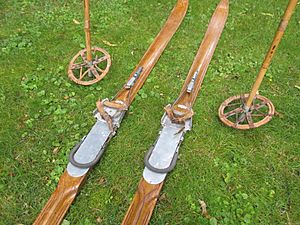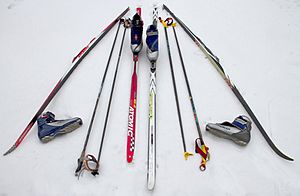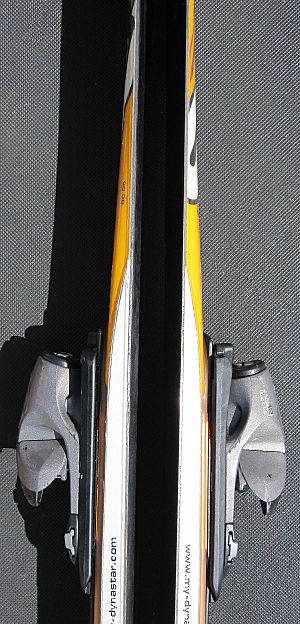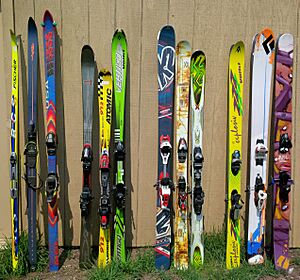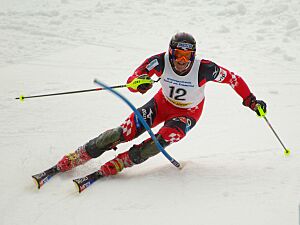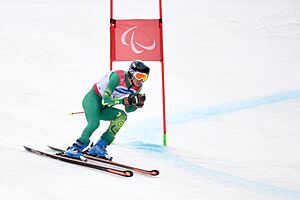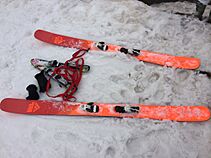Ski facts for kids

A ski is a long, narrow piece of material worn on your feet to glide over snow. Skis are usually used in pairs and are attached to special ski boots with ski bindings. These bindings can either let your heel move freely, lock it in place, or hold it partly. If you need to climb up snowy hills, you can attach special "ski skins" (which used to be made from seal fur but are now synthetic) to the bottom of your skis for grip.
Originally, skis were used for traveling across snow. Today, they are mostly used for fun in the sport of skiing.
What's in a Name?
The word ski comes from an old language called Old Norse. In Old Norse, skíð meant "cleft wood," "stick of wood," or "ski." People in Old Norse times would say fara á skíðum to mean "to travel fast on skis."
Many languages use a version of the word ski. For example, in English and French, we use the original Norwegian spelling, ski. In Italian, it's sci, and in Portuguese and Spanish, it's esqui.
However, some languages have their own ancient words for skis. For instance, in Finnish, "ski" is suksi, and "skiing" is hiihtää. The Sami also have their own words, like sabek for "ski" and cuoigat for "to ski."
A Brief History of Skis
Skis are very old, even older than the wheel! The oldest wooden skis ever found are from Russia (around 6300–5000 BCE), Sweden (around 5200 BCE), and Norway (around 3200 BCE).
These early skis weren't for racing or fun. Their main goal was to help people stay on top of the snow while hunting or during war. People often used a walking stick with these early skis to help them balance.
In the early 1900s, ski technology changed a lot. New ski and ski binding designs, along with the invention of ski lifts, helped create modern alpine skis. At the same time, new ideas in Nordic skiing led to special skis for skating and ski jumping.
Old Ski Designs

Some old skis were asymmetrical, meaning they weren't the same on both feet. People in northern Finland and Sweden used these until the 1930s. One ski was long and straight for sliding, while the other was shorter for pushing off. The short ski might have been covered with animal skin for better grip.
Another special ski was the single long ski, used by seal hunters in the Gulf of Bothnia. This ski was very long (3–4 meters) to help them move safely over packed ice and avoid cracks.
Modern Ski Innovations
Around 1850, skilled workers in Telemark, Norway, created the cambered ski. This ski curves upward in the middle, under your foot. This design helps spread your weight evenly along the ski. Older skis had to be very thick to avoid bending too much. The new cambered design allowed for thinner, lighter skis that could flex and absorb bumps better, making them faster and easier to control. This design also included a "sidecut," where the ski was narrower underfoot and wider at the tip and tail, making it easier to turn.
Originally, skis were carved by hand from a single piece of wood like hickory or birch. These woods were chosen because they were strong and could handle speed. As good wood became harder to find, people started making laminated skis by gluing layers of wood together. This began in Norway in 1891. Laminated skis were lighter and easier to handle.
At first, the glues used for laminated skis weren't waterproof, so the skis would often warp or split. In 1922, a Norwegian skier named Thorbjorn Nordby developed a strong, waterproof glue that solved this problem. This led to much tougher laminated skis.
In 1950, Howard Head introduced the Head Standard ski. This ski had a plywood core sandwiched between layers of aluminum alloy. It also had steel edges (first invented in Austria in 1928) and a special surface that could hold wax. This ski was very popular because it was made for everyday skiers, not just racers.
By the late 1960s, fibreglass skis became popular, largely replacing aluminum. In 1974, Magne Myrmo was the last world champion to win a cross-country race using wooden skis.
In 1993, the company Elan introduced the Elan SCX ski. These skis had a much wider tip and tail compared to their middle (waist). This "shaped" design made it much easier to carve turns. Other companies quickly copied this idea, changing how alpine skis were made forever. Later, in 1995, Line Skis introduced "twin-tip" skis, which have both ends curved up, allowing skiers to ski backward.
How Skis Are Shaped
A ski has three main parts: the front is the tip (usually pointed or rounded), the middle is the waist, and the back is the tail.
Skis have four key features that affect how they perform:
- Length: How long the ski is.
- Width: How wide the ski is at different points.
- Sidecut: The curve along the side of the ski. A deeper sidecut makes it easier to turn.
- Camber: The upward curve in the middle of the ski when it's resting on a flat surface.
Skis also have other features for specific uses. For example, mogul skis are softer to absorb bumps, powder skis are wider to float better on deep snow, and rocker skis (also called "reverse camber") curve up at the tip and tail, making them easier to turn in deep or heavy snow.
How Skis Are Built
Skis have come a long way from being just solid pieces of wood. Today, they are made from many different materials, including carbon-Kevlar, to make them stronger, lighter, and more durable. Skis are usually made using one of three main designs:
Layered (Laminate or Sandwich)
Laminated skis are built in layers, like a sandwich. Materials such as fiberglass, steel, aluminum, or plastic are layered and pressed together above and below a central core. This is the most common way skis are made today. The first successful modern laminated ski was the Head Standard in 1950, which had aluminum alloy around a plywood core.
Torsion Box
In this design, a smaller wooden core is wrapped in strong materials like fiberglass. This creates a "torsion box" that makes the ski much stronger and stiffer against twisting. This design is still very common for cross-country skis.
Cap (Monocoque)
The "cap ski" design covers the ski's core with a single outer shell, usually made of plastic. This method is simpler and cheaper to produce. Cap ski construction is very popular for alpine skis today.
Old Wooden Skis
Traditional wooden skis were made from a single long piece of wood, shaped by hand. Early designs were often rectangular, with the tip bent up using steam. Over time, designs changed, making skis thinner on the sides or adding ridges down the middle.
Popular Ski Brands
- K2: A big US ski company that started making fiberglass skis in 1961. They are known for their torsion-box ski designs.
- Rossignol: A French company started in 1907. They introduced their first fiberglass ski in 1964 and now make over 500,000 pairs of skis each year.
- Elan: A Slovenian company famous for inventing shaped skis (also called parabolic skis). These skis made it much easier to carve turns, even at slower speeds.
Different Kinds of Skis
Over time, many different types of skis have been created for different needs. Here are some of the main ones:
Alpine Skis
Alpine skis, also called downhill skis, are made for skiing at resorts where you use ski lifts to go up the mountain. Modern alpine skis usually have steel edges, camber, sidecut, and sometimes reverse camber. In the 1990s, skis got a more pronounced sidecut, making it much easier to carve turns. Alpine skis usually have bindings that fix your heel to the ski.
Here are some common types of alpine skis:
| Type | Design | Description |
| Twin-Tip | These skis have both the tip and the tail curved upward. This design lets skiers land jumps while facing backward, making them great for terrain parks, jumps, rails, and boxes. | |
| Slalom | Slalom skis are designed for racing. They have a very narrow middle section compared to the tip and tail. This shape allows for quick, tight turns needed in slalom races where gates are close together. | |
| GS | GS skis are for giant slalom racing. They are longer and a bit wider in the middle than slalom skis. This allows for wider turns needed when gates are spaced further apart. | |
| Powder | Powder skis are very wide, especially in the middle. Their width helps them float on top of deep, soft powder snow, making it easier to ski without sinking. | |
| Telemark | Telemark skis are used for telemark skiing, which mixes alpine, ski-jump, and cross-country styles. The skis are similar to regular alpine skis but often lighter. The main difference is the binding, which attaches only the toe of the boot, leaving the heel free to lift. | |
| Monoski | A monoski is like two skis joined into one wide board. You stand with both feet side-by-side, facing forward. It looks a bit like a snowboard but is usually wider, heavier, and has bindings more like regular skis. |
Backcountry Skis
Backcountry skiing means skiing outside of marked ski resort areas. People often use alpine touring skis or telemark gear for this. These setups allow skiers to attach "climbing skins" to the bottom of their skis and free their heels to walk uphill. Once they reach the top, they remove the skins and lock their heels down to ski back down.
Nordic Skis
In Nordic skiing, you don't rely on ski lifts. Skis and boots are usually lighter, and your heel is free to move, which makes walking and climbing easier. Types of Nordic skiing equipment include:
- Cross-country skis are light and narrow with a slight sidecut. They are waxed to glide smoothly, and sometimes "grip wax" is added to the bottom for traction when pushing off. Some skis have patterns on the bottom instead of needing grip wax.
- Skating skis are shorter than classic cross-country skis and don't need grip wax. This style is used in sports like biathlon.
- Ski jumping skis are very long and wide to help jumpers glide far through the air.
- Roller skis have wheels instead of a flat base. They are used on dry pavement when there's no snow.
Ski Poles
Ski poles are often used with skis. They help skiers with balance, turning, walking, and getting up after a fall.
Taking Care of Your Skis
Taking care of your skis involves four main things: adjusting bindings, waxing, sharpening edges, and repairing the base.
- Binding Adjustments: Ski bindings are designed to release your boot if you fall, to prevent injuries. They need to be adjusted correctly for your weight and height.
- Waxing: Most ski wax helps your skis glide smoothly over the snow. For cross-country skis, "grip wax" is also used to help you push off. Wax can be applied by melting it on, rubbing it on, or using a paste.
- Edge Sharpening: The metal edges on your skis help you grip the snow, especially on icy slopes. The angle of the edges is set depending on how you ski. Edges can be sharpened regularly to keep them working well.
- Base Repair: The base is the bottom of your ski. If it gets scratched or gouged, it can be repaired by filling the marks with a special material and then smoothing it out.
See also
 In Spanish: Tabla de esquí para niños
In Spanish: Tabla de esquí para niños



